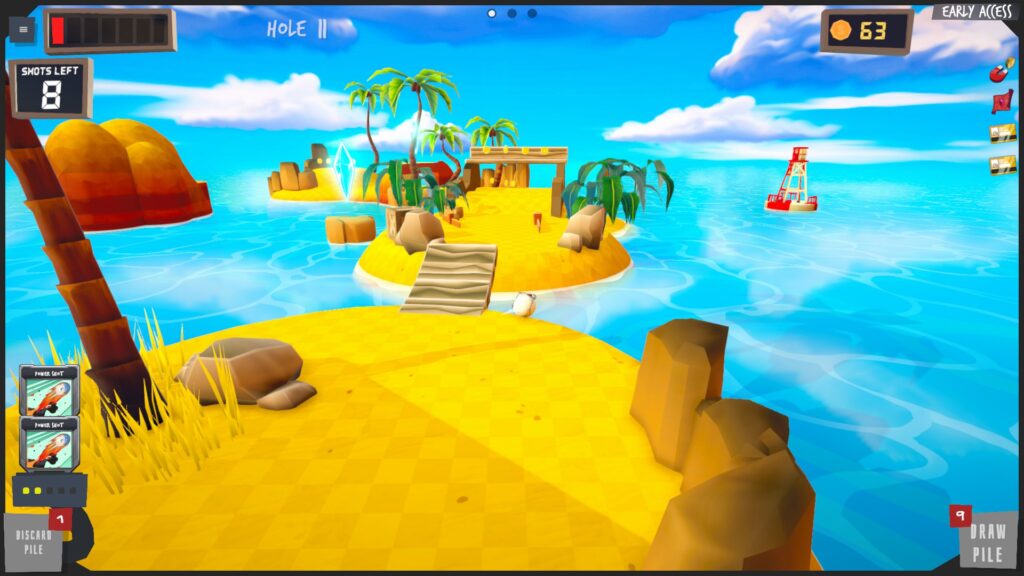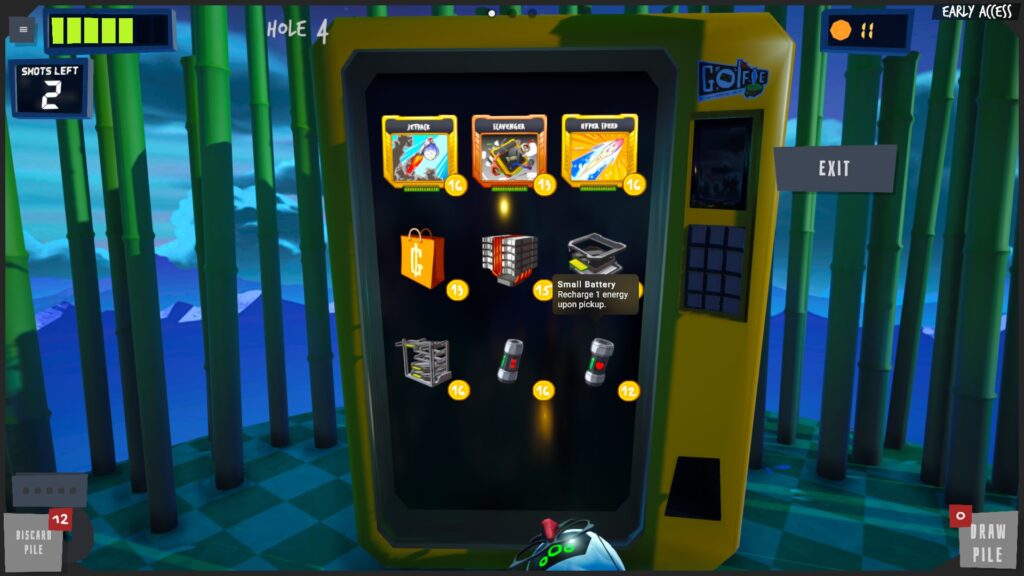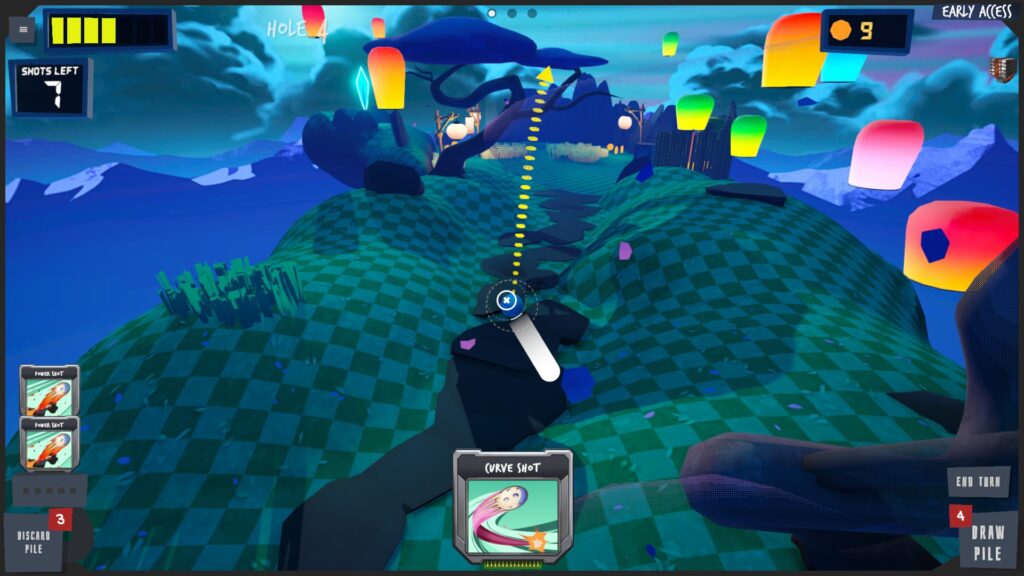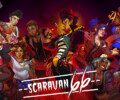
Developer: Triheart Studio
Publisher: Yogscast Games
Platform: PC
Tested On: PC
Golfie – Preview
Surprising as it might be, golf games have recently seen an increase in popularity. Titles such as Golf Story, What The Golf? and Golf Club Wasteland have brought the genre to a mainstream audience while providing unique takes on the usual mechanics. Similarly to these, Golfie also provides its own twist to the sport, turning it into a deckbuilding roguelike. Here is how it works.
Golfie does not have a story to speak of; players are simply thrust into the game and left to their own devices. While an intro is seemingly planned further down the roadmap, its extent hasn’t been revealed, and thus speaking about it would only be speculation.
The game’s graphics are composed of colorful 3D models. These models are split into different themes and are utilized to generate several presets that are later randomly arranged into levels. Currently, the themes are best described as Asian, Dungeon, Beach, and Floating, which also change the gimmicks featured in their levels. At the moment, Golfie doesn’t feature enough variation to make the majority of a run unique. After only a few levels or attempts players will already recognize the design patterns at a glance.
Something similar applies to the game’s sound design, which features decent SFX and a competent soundtrack. However, said soundtrack is only competent from a quality standpoint, not from a quantity one, currently only featuring a single song per theme which continually loops until the next one. As it may be expected, this soon turns grating, especially when a run takes over half an hour and the same themes are constantly revisited.
As previously stated, the game is a deckbuilding roguelike take on a golf game. What this entails is that players will obtain cards with modifiers for their ball and shots, which they’ll use to reach the hole in the least possible moves. Each of the levels has a maximum of possible shots, with players being rewarded depending on how many they have left at the end. However, should a player go over this maximum, they’ll start taking damage on each shot past the max, quickly depleting their health.
Alongside the different cards players may accrue throughout the run, they’ll also be able to obtain perks. These perks provide passive benefits such as healing up after collecting money, a longer trajectory prediction, and more. That said, most of these benefits are rather minimal and are unlikely to change a run unless their effects are stacked several times.
In order to obtain more cards and perks, players will have to hit red and blue crystals spread throughout the levels, which will then provide a random selection of options. Besides this, vending machines will also appear in some areas, where the money obtained can be used to purchase new trinkets or to delete cards from the deck. This last option has only recently been included in the game, increasing in price every time it’s used.
Other than this, the game doesn’t really have any other mechanics. Whilst players will have to be mindful of the hazards featured in the stages, most of the challenge simply comes from trying to win in as few moves as possible. The main problems players will face to accomplish this goal are mostly due to the deckbuilder nature of the game, which may leave them without good shots to move their ball.
This is a rather large issue, since the unmodified shot barely has any power or effect, making power shots pretty much required to get anywhere. On top of this, a lot of cards tend to be gimmicky and lack a proper use, making their existence questionable. While some like the jetpack or jump (which can be activated at will by the player) are useful, some like hyper speed will often make a player lose health. All this leads to a point where players might be better off leaving their deck with only power and lob shots, guaranteeing their ability to do something each turn.
Topping this off, there are plenty of issues with the camera, which often impedes proper sight of the trajectory. Without an indicator as to where the ball will land or the trajectory line ends, players are often left without a way to measure the depth of their shot. Although the camera may be unlocked and moved around, doing so is still rather uncomfortable and doesn’t solve the issue due to the game’s control scheme.
Conclusion
Golfie is an interesting take on a golf game that still needs much polishing. The game is currently rather barebones, offering little variation even after unlocking a decent amount of the available cards. While a multiplayer mode is also planned for the game, it isn’t currently available either, thus further making the game lacking content at this point in time. Sold for $/€17,99/£14,99, waiting for the full release or at least a later part of the Early Access is very recommendable.
Personal Opinion
“While I enjoyed my time with Golfie, what was mentioned in the review still stands. The game is still very much lacking in variation and content. Any given run will see you going through the same themes several times, often in a row. To make things worse, aiming is pretty clunky, especially when the camera corners you, which happens rather often in the dungeon map. Asking players to make trickshots while not providing a proper way to see where they’re shooting is a surefire way to make your game way less enjoyable than it could be. Besides this, in my opinion the deckbuilding system needs to be reworked somehow, perhaps including a guaranteed power shot in each hand, increasing the power or the default putt or something along those lines. If my best option is to remove every card, besides the most basic ones and perhaps a jetpack, then the deckbuilding is not well implemented.”









No Comments